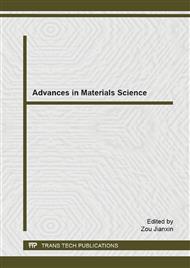p.206
p.213
p.217
p.221
p.227
p.233
p.238
p.242
p.245
The Compressive Behaviors of the Mg-Zn-Er Alloy Containing I-Phase
Abstract:
The microstructure and compressive behaviors of the Mg-Zn-Er alloy reinforced by I-phase were investigated. The XRD results suggested that the as-cast alloy was composed of -Mg and I-phase. During compress test, the deformation mechanism was depended on the test temperature and strain. It indicated that basal plane slip played an important role in deformation at both low and high temperature. However, the main deformation mechanism of the as-cast alloy includes grain boundary sliding and twins forming at the strain of 20% at a moderate temperature (225oC) besides the basal plane slip. Moreover, the DRX occurred at the moderate temperature after the strain of 50%. At high temperature (more than 300oC), the cavity was present, and the volume fraction of the cavities increases with the temperature increasing. At the high temperature, the deformation mechanism of the as-cast alloy is mainly dislocation sliding and climbing.
Info:
Periodical:
Pages:
227-232
Citation:
Online since:
February 2015
Authors:
Price:
Сopyright:
© 2015 Trans Tech Publications Ltd. All Rights Reserved
Share:
Citation:


